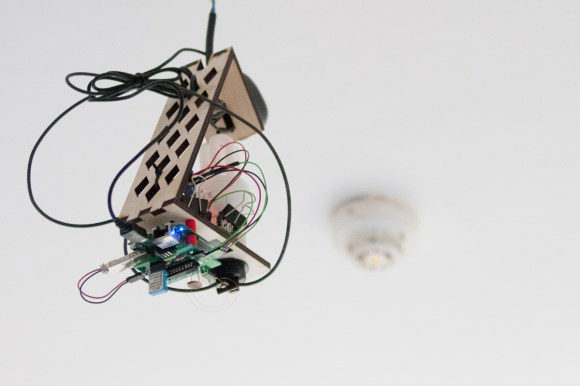
Would you believe that this beautiful light fixture is actually a hacked together home automation project? Okay, so this wire mess is the second of three versions that [Christian] built. It replaces a light fixture in the room, but if you look closely you’ll see that there is a compact fluorescent bulb included in the build. The laser-cut frame acts as a bit of a lamp shade, while providing a place to mount the rest of the hardware.
The final version cleans things up a bit, and adds a footprint for the PIR motion sensor that he forgot to design into this version. The idea is that each lamp monitors motion in the room, switching the light on and off again as necessary. A light-dependent resistor ensures that the bulb is only powered up if the room is dark so as not to waste electricity during the day.
The build includes a sensor package that reports back temperature and humidity data. Communications are provided by a WR703N router rolled into each of the four units installed in his house. With this kind of hardware at his disposal it should be a snap to control every IR remote control device in his house via the network by adding an IR LED and some code to the lamps.















I really like this idea. I will have to look in to making something like this thought to get it past the girlfriend I will need to hide all the electronics.
A nice desk or floor lamp would be good as an “enclosure”. An empty box that looks like an over-sized antique book, like is sold at craft stores, would be a nice second choice.
I was thinking something more along the lines of ceiling medallion to put the electronics inside.
http://www.lowes.com/pd_338771-1811-CM22H_0__?productId=3351876&Ntt=ceiling+medallion&pl=1¤tURL=%3FNtt%3Dceiling%2Bmedallion&facetInfo=
I’ve tried the Motion sensing fixture thing before. It turns out that cfl bulbs don’t like being power cycled too often.
We spent more money replacing bulbs than we saved in electricity. Allegedly, LED bulbs don’t have that issue, but I haven’t tested it myself.
That is correct, the reason CFL (or FL) have problems being turned on often is the heating element and related driving electronics, it’s simply not built to operate too often, and if it does it burns out.
A (correctly built) LED lamp can be switched on and off as often as you want, once every 10 seconds for a year according to some rather rough tests. The LEDs themselves have no problems being switched on and off 1000 times per second for 20 years…
http://www.legrand.us/dimmers-switches/motion-sensors.aspx#.UVuXyFf_EoQ
Mike, I really like your style of writing! Always an interesting read :)
Nicely done, but motion sensors will tend to shut the light off at all of the wrong moments. Sit still long enough (depending on the timing circuit used) and the light goes out. Not much of a problem if you’re in the living room watching TV, but if you’re on the toilet it’s a bit less convenient (I’ve had this very thing happen to me in a public restroom with motion sensor lights).
Two things I would change/add would be able to set how long before the light turned out and have a way of setting it to on/automatic/off
I would also attempt to secure one of those extremely sensitive PIR modules that will sense any movement in the room. I would then pair that with a regular PIR or if possible use a selectable gain.
Low sensitivity when off, high sensitivity when on, so it takes a person moving a lot to turn it on (no turning on from something falling over, or smaller pets) but it takes absolute stillness to turn it off.
Ideally one would have a thermal camera in the lamp to detect 37 degree C heat sources in the room, but that will have to wait until the price goes down on those cameras.
Thanks :) I agree, the motion sensor + light combination only works for certain environments. That’s why I only use that combination only in the hallway (so that I don’t have to try and turn the light on when I come home at night trying to shove my bike through the door) and kitchen (even while cooking there is enough movement to keep the motion sensors happy).
I’d rather track heat with IR than motion. I hate a lamp that goes off when I’m sitting still.
Nice hack, for the utterly raw and trashy look. However you can actually buy light fixtures like that for decades.
There are some in the office where i work. It comes with some quirks as it sometimes does not “see” you when you are alone in the office and are not moving around too much. Nothing better than the machine disregarding the presence of the puny human.
What is the power consumption of the system with the lamp off ?
About 0.5W, due to the wr703n – MSP430 and the occasionally queried sensors don’t add much.
That sounds very low considering the switching power supply. A couple of watts of the grid is more likely.
The power supply is wasting a lot. Each of his “lamps” are burning 2-3 watts 24 hours a day 7 days a week. He needs to design a better power supply so the waste is down to .2 watts
good point – I probably underestimated the power consumption of those cheap power supplies. However, I’m not an electrical engineer hence would be unable to design a better power supply.
Are there schematics, projects or even (low-priced) commercial products for low-overhead supplies that someone could recommend?
At my old house we had a regular motions sensor instead of a switch in the toilet from about 25 to 10 years ago. Worked well, although during long… intervals, you’d have to wave your hand up to trigger the light again.
This would only really work for regular rooms if you set the time to something long, at least half an hour. You’re bound to twitch during that time.
There are already many commercial options for this. is he going to be able to get the price down to what makes most HAD guys not whine? (That would be a $3.25 price point for the cheapskates here) Because this year the Belkin WeMo will have wall switches that will do this. and at $50.00 a switch they are actually dirt cheap when the real stuff costs $220.00 a switch.
The Belkin WeMo is kind of cheap, indeed (40 GBP across the pond – 60 USD). However, it can only turn things on and off while I’m much more interested in all the sensor data. I intend to use this data as my personal living lab for activity recognition and context inference targeting quantified self ideas.
this would be problematic at night with pets wandering about the house… you’d be “those people” that had the blinky house… not likely to curry favor with the neighbors.
Because the burglars will be going to their houses, and leaving the blinky house alone.
No, the burglars will be going to the house with the randomly blinking lights, thinking that the owners are away and the lights are controlled by those random anti-burglar timers.
Most PIR sensors have a setting to ignore dogs and the like. And if my neighbors are concerned my lights are turning on and off, i gotta move anyway man.